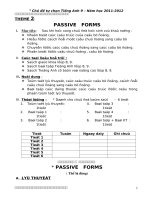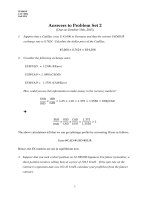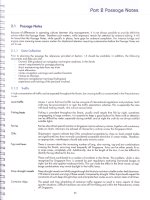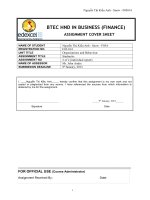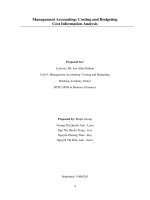1625 assignment 2 (pass)
Bạn đang xem bản rút gọn của tài liệu. Xem và tải ngay bản đầy đủ của tài liệu tại đây (1.92 MB, 62 trang )
Higher Nationals in
Computing
Unit 06: Managing a Successful Computing
Project
ASSIGNMENT 1
Assessor name: NGO QUOC ANH
Learner’s name: Đào Vĩnh Khang
ID: GCS200222
Class: GCS0905B
Subject code: 1625
Assignment due: 3 1/ 0 1 / 2023
/2023
Assignment submitted: 3 1/ 0 1
ASSIGNMENT 2 FRONT SHEET
Qualification
BTEC Level 5 HND Diploma in Computing
Unit number and title
Submission date
Unit 06: Managing a Successful Computing Project
14-02-2022
Date Received 1st submission
Re-submission Date
14-02-2023
Date Received 2nd submission
Student Name
DAO VINH KHANG
Student ID
GCS200222
Class
GCS0905B
Assessor name
NGO QUOC ANH
Student declaration
I certify that the assignment submission is entirely my own work and I fully understand the consequences of plagiarism. I understand that
making a false declaration is a form of malpractice.
Student’s signature
Grading grid
P1
P2
M1
M2
D1
D2
KHANG
❒ Summative Feedback:
Grade:
Signature & Date:
❒ Resubmission Feedback:
Assessor Signature:
Date:
ASSIGNMENT 1 BRIEF
Qualification
Unit
number
and title
BTEC Level 5 HND Diploma in Computing
Unit 06: Managing a Successful Project
Assignment title
Plan and conduct a small scale research activity
Academic Year
2022 - 2023
Unit Tutor
Do Tien Thanh
Issue date
03 August 2022
Submission
date
Submission Format:
Format:
The submission is in the form of an individual written report that shows how you have manage
the project. This should be written in a concise, formal business style using single spacing and
font size 12. You are required to make use of headings, paragraphs and subsections as
appropriate, and all work must be supported with research and referenced using the Harvard
referencing system. Please also provide a bibliography using the Harvard referencing system.
Submission Students are compulsory to submit the assignment in due date and in a way requested by the
Tutors. The form of submission will be a soft copy in PDF posted on corresponding course of
/>Note:
The Assignment must be your own work, and not copied by or from another student or from
books etc. If you use ideas, quotes or data (such as diagrams) from books, journals or other sources,
you must reference your sources, using the Harvard style. Make sure that you know how to reference
properly, and that understand the guidelines on plagiarism. If you do not, you definitely get fail
Assignment Brief and Guidance:
Introduction
The environmental impact of digital transformation
The amount of data created and stored globally is expected to reach 175 Zettabytes by 2025, a six-fold
increase from 2018. This will demand additional hardware and power consumption, which; in turn, will
increase the environmental impact of the digital sector and there is already increasing attention on the
environmental footprint of ICT equipment and services as they become more widespread in all aspects
of human life.
It is the responsibility of everyone to take action in addressing the challenges of climate change, as
professionals we must also seek ways that the digital sector can play its part. While digital technologies
are one of the sectors that has achieved greater efficiency; achieving about 100 times more
computation power from the same amount of energy per decade, it remains unsustainable. The sector
must continue to seek ways in which it can continue to support and drive innovation, while addressing
the global climate emergency for a greener and fairer future.
This unit will enable students to explore the impact of digital endpoint devices and ways to reduce
environmental damages, OR the potential of refurbishing, repairing and reusing digital devices rather
than replacing
Tasks
As a member of Research and Development department, you have been assigned a mini-project to find
out the impact of digital endpoint devices and ways to reduce environmental damages, OR the
potential of refurbishing, repairing and reusing digital devices rather than replacing.
You need to do primary research (both qualitative and quantitative research) and secondary research
to find out that impact and conduct a report for your research. Even it’s a mini-project, you must apply
project management (PM) techniques such as project charter with aims, objectives, cost etc. As for time
management, you need to produce WBS and Gantt chart with reasonable tasks and time. A project
logbook is required to provide evidence of the project development process and ongoing reflection for
every week. This logbook will be needed later for your reflection and evaluation in Assignment 2. As
part of QA (quality assurance) policy, in the report you also need to critically evaluate the PM process
and appropriate research methodologies applied.
Your report must have an introduction stating the project aims and objectives. This must be followed
by a copy of your project management plan. Your plan should show the milestones when you will review
with your tutor your ongoing progress so far. You will submit your logbook which shows how you have
carried out the project.
Learning Outcomes and Assessment Criteria
Pass
Merit
LO1 Establish project aims, objectives and timeframes based on the
chosen theme
P1 Devise project aims and
objectives for a chosen
scenario.
P2 Produce a project
management
plan
that
covers aspects of cost, scope,
time,
quality,
communication, risk and
resources.
M1 Produce a comprehensive
project
management
plan,
milestone schedule and project
schedule for monitoring and
completing the aims and
objectives of the project.
P3
Produce
a
work
breakdown structure and a
Gantt Chart to provide
timeframes and stages for
completion.
LO2 Conduct small-scale research, information gathering and data
collection to generate knowledge to support the project
P4 Carry out small-scale
research
by
applying
qualitative and quantitative
research
methods
appropriate for meeting
project aims and objectives
M2 Evaluate the accuracy and
reliability of different research
methods applied.
Distinction
LO1 & LO2
D1. Critically evaluate the
project management process
and appropriate research
methodologies applied.
Table of Contents
Contents
ASSIGNMENT 2 FRONT SHEET ...................................................................................................................... 5
P1 Devise project aims and objectives for a chosen scenario ......................................................................... 2
1. The advantages of using project management and why it is important ................................................. 2
2. Research project proposal ..................................................................................................................... 3
P2 Produce a project management plan that covers aspects of cost, scope, time, quality, communication,
risk and resources ............................................................................................................................................ 5
1. Project scope ........................................................................................................................................... 5
2. Project time ............................................................................................................................................. 7
3. Project resources .................................................................................................................................... 8
4. Project cost ............................................................................................................................................. 8
5. Project quality ......................................................................................................................................... 9
6. Project risk .............................................................................................................................................. 9
P3 Produce a work breakdown structure and a Gantt Chart to provide timeframes and stages for completion
....................................................................................................................................................................... 10
1. Requirements analysis .......................................................................................................................... 10
1.1. Define requirement............................................................................................................................ 10
1.2. Work Breakdown Structure (WBS) .................................................................................................... 11
2. Gantt chart ............................................................................................................................................ 13
P4 Carry out small-scale research by applying qualitative and quantitative research methods appropriate
for meeting project aims and objectives ....................................................................................................... 21
1. Qualitative research ................................................................................. Error! Bookmark not defined.
2. Quantitative research ........................................................................................................................... 32
3. Evaluation about interview and survey ................................................................................................ 38
M1 Produce a comprehensive project management plan, milestone schedule and project schedule for
monitoring and completing the aims and objectives of the project ............................................................. 41
1. Comprehensive project manager plan.................................................................................................. 41
2. Milestone schedule ............................................................................................................................... 45
M2 Evaluate the accuracy and reliability of different research methods applied ........................................ 48
Page|1
1. Different between research methods applied...................................................................................... 48
2. Evaluate ................................................................................................................................................. 50
D1. Critically evaluate the project management process and appropriate research methodologies applied.
....................................................................................................................................................................... 50
REFERENCES ................................................................................................................................................... 51
ASSIGNMENT 1 ANSWERS
P1 Devise project aims and objectives for a chosen
scenario.
1. The advantages of using project management and why it is important
The main advantage of project management is that helps you to manage your projects effectively,
enabling you to resolve problems more quickly. It takes time and money to manage a project, however
following good practices can help you:
•
Improve your chances of achieving the desired result
•
Gain a fresh perspective on your project, and how it fits with your business strategy
•
Priorities your business’ resources and ensure their efficient use
•
Set the scope, schedule and budget accurately from the start
•
Stay on schedule and keep costs and resources to budget
Page|2
•
Improve productivity and quality of work
•
Encourage consistent communications amongst staff, suppliers and clients
•
Satisfy the various needs of the project’s stakeholders
•
Mitigate risks of a project failing
•
Increase customer satisfaction
•
Gain a competitive advantage and boost your bottom line
Not having a process to manage your projects can result in lost time, wasted money, inconsistencies and
poor performance. Find out more about the benefits of following a project management method.
2. Research project proposal
Research Topic:
The research topic is the development of an automatic robotic vacuum cleaner controller
by smartphone. The aim of the research is to investigate the feasibility and effectiveness
of controlling a robotic vacuum cleaner through a smartphone application.
Research Scope:
The research will focus on designing and developing a smartphone application that
allows users to control their robotic vacuum cleaner automatically. The scope of the
research will cover the following areas:
Identification of the key features required for an effective smartphone application to
control a robotic vacuum cleaner.
Design and development of the smartphone application.
Evaluation of the effectiveness of the smartphone application in controlling the robotic
vacuum cleaner.
Research Methodology:
Page|3
The research methodology for this project will involve a mixed-methods approach that
combines both quantitative and qualitative data collection and analysis.
Quantitative research:
The quantitative research will involve collecting numerical data through a survey
questionnaire. The questionnaire will be designed to identify the key features required
for an effective smartphone application to control a robotic vacuum cleaner. The survey
will be distributed to a sample of potential users of the smartphone application. The
collected data will be analyzed using statistical methods to identify the most important
features that the smartphone application should have.
Qualitative research:
The qualitative research will involve conducting user testing and feedback to evaluate
the effectiveness of the smartphone application. Users will be invited to test the
smartphone application and provide feedback on its usability and effectiveness. The
feedback will be collected through interviews and focus group discussions. The collected
qualitative data will be analyzed using content analysis to identify themes and patterns
in users' feedback.
Overall, the mixed-methods approach will allow us to gather both quantitative and
qualitative data that complement each other and provide a more comprehensive
understanding of the research problem. This will help us to design and develop an
effective smartphone application that can control a robotic vacuum cleaner.
Data Requirement:
To achieve the research objective, the following data requirements have been identified:
Compose a question: What are the key features required for an effective smartphone
application to control a robotic vacuum cleaner?
Page|4
How to collect data: The data will be collected through a survey of potential users of the
smartphone application. The survey will be distributed online and will include questions
about the users' preferences for controlling a robotic vacuum cleaner through a
smartphone application.
The data collected from the survey will be used to identify the key features required for
an effective smartphone application to control a robotic vacuum cleaner. This
information will be used to design and develop the smartphone application. The
effectiveness of the smartphone application will be evaluated through user testing and
feedback.
P2 Produce a project management plan that covers
aspects of cost, scope, time, quality, communication, risk
and resources.
1. Project scope
PROJECT SCOPE
Project Goal:
Research to develop the automatic robotic vacuum cleaner controlled by smartphone aims to provide
consumers with modern and automated living.
Page|5
Scope Description:
Research to develop the automatic robotic vacuum cleaner controlled by an application on user’s
smartphone.
Technology companies and research groups alike recognize the potential for smartphones, IoT devices,
and smart home technology to install electrical and electronic equipment can be controlled automated
or semi-automatic, replacing humans in performing one or several operations of management and
control. This electronic system communicates with the user through a home electronic board, mobile
phone application, tablet or a web interface.
Deliverables:
•
Application for everyone in or out of the country.
•
User manuals, support service 24/7.
•
Research document.
•
Application document.
Acceptance criteria:
•
Navigation system and programming
It is important to compare the navigation systems which must be simple, efficient, have a good obstacle
managing, and have a precise vacuum of surfaces.
•
The filter of the vacuum cleaning robot
There are plenty of different filter types which allow a more or less efficient cleaning of your floors:
classical filters, anti-allergen filters to hold more dust particles or HEPA filter (High Efficiency Particles
Arresting) defining devices able to filter in one time more than 99, 97% of particles.
•
The noise level of the robot
This point is essential if you wish to make your robot work during the night but will be less essential if
you are planning to make it work while you’re not at home. You need to see according
Page|6
to your needs which criteria to prioritize: noise, performance, programming...
• Price for a vacuum cleaning robot
The price of robotic vacuum cleaners sold in Vietnam ranges from 4 million to 15 million. The vacuum
quality, noise level, type of programming/navigation, quality of sensors or even additional functionalities
such as vocal command, can make your price higher.
Assumptions:
•
The collected data of positive patients coincided with 90% of the statistical data in the report.
•
The personal information in the report will be kept confidential.
•
During the completion of the report, the change of data can be calculated.
•
Meet 88% of the requirements needed in application development.
2. Project time
PROJECT TIME
Task name
Start
Finish
Duration
Research to develop the automatic robotic vacuum
cleaner controlled by smartphone.
January 12, 2023
March 11, 2023
58 days
1. Initiation Phase
January 12, 2023
January 20, 2023
8 days
2. Planning/Design Phase
January 21, 2023
February 2,2023
12 days
3. Execution Phase
February 3, 2023
February 9, 2023
6 days
February 10, 2023
February 22, 2023
12 days
4. Monitor and Control Phase
Page|7
5. Close-out Phase
February 23, 2023
March 11, 2023
16 days
3. Project resources
HUMAN RESOURCES
No.
Name
Role
Phone Number
1
Dao Vinh Khang
Project manager
0834684568
2
Dao Vinh Khang
Data Analysist
0834684568
3
Dao Vinh Khang
Interface Development
0834684568
4
Dao Vinh Khang
Tester
0834684568
4. Project cost
HUMAN RESOURCES COST
Staff name
Start date
End date
Duration
Assignment cost
Dao Vinh Khang
January 12, 2023
March 11, 2023
58 days
$1740
Dao Vinh Khang
January 12, 2023
March 11, 2023
58 days
$1450
Dao Vinh Khang
January 21, 2023
March 11, 2023
45 days
$1225
Page|8
Dao Vinh Khang
February 10, 2023
March 11, 2023
TOTAL COST
18 days
$580
$4995 + 10% Buffer = $5495
5. Project quality
-
The project collects information from various sources, validated and verified. The goal is to seek
out and fully comply with the law.
-
The app interface connects to the robot designed for ease of use, giving users a great experience.
Receive customer feedback and constantly update products.
6. Project risk
•
Probability Values: Likely, Possible, Unlikely
•
Severity Values: Serious, Moderate, Minor
PROJECT RISKS
No.
Risk Category
Severity
Probability of
occurrence
Lack of quality researchers
Serious
Likely
2
Researchers cannot be recruited
Serious
Possible
3
Data is lost
Serious
Unlikely
4
Data is not secured
Serious
Unlikely
5
Data collection is unverified
Moderate
Unlikely
1
Risk event
Research team
Research process
Page|9
6
Research has low chance of achieving
outcomes
Moderate
Possible
7
Misconduct or fraudulent behavior
Moderate
Unlikely
8
Research data is falsified
Moderate
Unlikely
Research integrity
P3 Produce a work breakdown structure and a
Gantt Chart to provide timeframes and stages for
completion.
1. Requirements analysis
1.1. Define requirement
•
Project Idea
Identify and design an autonomous robot that can assist people at home who are too busy for daily or
weekly floor cleaning, for families with children. In particular for the elderly who live by themselves
and do not have the strength or ability to clean.
•
Data Collection
Customer information security surveyed about the need to use robotic vacuum cleaner. The project
collects information from various sources, validated and verified. The goal is to seek out and fully
comply with the law.
• User requirement research
Meet all of user requirements about using robotic vacuum cleaner.
•
Evaluate and analyze
Users will insert their information in the app and connect the app on their phone with their robotic
vacuum cleaner. The system will track user and will evaluate, analyze the average time user use the
application to control robotic vacuum cleaner in 1 day, 1 week or 1 month.
P a g e | 10
•
Report
We will try to fix and upgrade the system also as application according to user feedback.
1.2. Work Breakdown Structure (WBS)
Describe
1. Project Initiation: In this phase, the research project is initiated by conducting market research and
analyzing the accessibility of the target market. The research team also conducts a review of similar
products in the market to identify potential competitors. Finally, they analyze and evaluate the system
requirements and features needed to develop an automatic robotic vacuum cleaner controller by
smartphone.
2. Project Planning: Once the project has been initiated, the research team defines the project scope
and objectives. They then develop a project schedule, create a budget, identify project risks, and develop
a risk management plan. Additionally, they define the roles and responsibilities of the project team
members.
3. Research Execution: In this phase, the research team conducts a literature review of existing
research on automatic robotic vacuum cleaner controllers. They design a research methodology, collect
and analyze data related to the features and functionality of the product, and develop a conceptual and
theoretical framework for the research.
4. Data Analysis: The research team prepares the collected data for analysis, conducts descriptive and
inferential statistics, and interprets the results to draw conclusions. Based on their findings, they develop
recommendations for the development of the product.
5. Reporting and Dissemination: The research team writes a research report summarizing their
findings and prepares a presentation to disseminate the research findings to relevant stakeholders. They
also publish a research article in an academic journal.
6. Project Closure: Finally, the research project is closed by obtaining approval of the research report,
archiving research data and documentation, and releasing project resources.
P a g e | 11
lOMoAR cPSD| 17507882
v
Figure 7: Work breakdown structure (WBS) of my project.
P a g e 12
|
2. Gantt chart
1. Schedule
Estimate time for all tasks
Task ID
Task Name
Time ( Days )
A
Start
0
B
Get Data
1
C
Get Measure
1
D
Get Material
1
E
Prototype
2
F
Testing
2
G
Adjust Prototype
3
H
Final Test
3
I
Survey
4
J
Finish
0
P a g e 13
lOMoAR cPSD| 17507882
-
Critical Path: Project duration
EFH 9 days
GHI 10 days
BCD 3 days
Task ID
Task Name
A
Start
Task
Dependency
Null
B
Get Data
A
C
Get
Measure
A
D
Get Material
A
E
Prototype
B, C, D
F
Testing
E
G
Adjust
Prototype
F
H
Final Test
G
I
Survey
H
J
Finish
I
P a g e 14
|
P a g e 15



